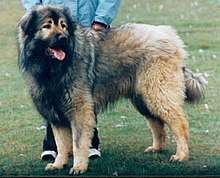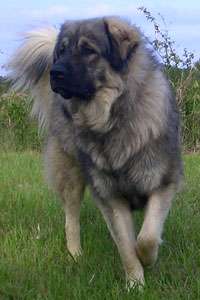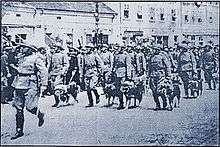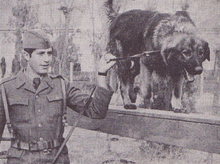Šarplaninac
The Šarplaninac (Albanian: Qeni i Sharrit, Macedonian: Шарпланинец, Serbian Cyrillic: Шарпланинац),[3] formerly known as Illyrian Shepherd Dog (Albanian: Deltari Ilir, Macedonian and Serbian: Илирски Овчар, romanized: Ilirski Ovčar), is a dog breed of the livestock guardian type. It is named after the Šar Mountains (Šar Planina), a mountain range in the Balkans that extends from Kosovo[lower-alpha 1] and the northwest of North Macedonia, to northeastern Albania. It is a molosser-type mountain dog. In Ottoman times, the dogs of the breed spent the summer in the area of the Šar Mountains and the winter in Thessaly, depending on the needs of the sheep they are used to protect.[2][4]
| Šarplaninac | |||||||||||||||||||||||||||||
|---|---|---|---|---|---|---|---|---|---|---|---|---|---|---|---|---|---|---|---|---|---|---|---|---|---|---|---|---|---|
 | |||||||||||||||||||||||||||||
| Origin | Šar Mountains[1][2] | ||||||||||||||||||||||||||||
| |||||||||||||||||||||||||||||
| |||||||||||||||||||||||||||||
| Dog (domestic dog) | |||||||||||||||||||||||||||||
Name
The dog breed is named for the Šar Mountains.[2][1] It is alternatively named the Yugoslavian Shepherd Dog by the Fédération Cynologique Internationale (1980), Albanian Mountain Dog, Greek Shepherd Dog and Šarplaninec[3][2] The breed was initially standardised by the Yugoslavian Federation of Cynology (Jugoslovenski kinološki savez, JKS) and recognised as a Yugoslavian breed with two types by the Fédération Cynologique Internationale (FCI) in 1939 under the designation Ilirski ovčar ("Illyrian Shepherd Dog"), FCI-Standard N° 41. Kraški ovčar and Šarplaninac were considered Type A and B of the breed. In 1957 the General Assembly of the F.C.I. accepted a motion proposed by the Yugoslavian Federation of Cynology to change the name of the breed to Jugoslovenski ovčarski pas Šarplaninac ("Yugoslavian Shepherd Dog Sharplanina"), and this is the official name of the breed. In 1968, type B was recognised as a separate breed under the designation Kraški ovčar ("Karst Shepherd Dog"), [5][6] The breed was formerly known as Ilirski Ovčar (Cyrillic: Илирски овчар, "Illyrian Shepherd Dog") before it was renamed in 1957.[3]
Origin
Like other European breeds, the Sarplaninac breed is believed to have origin from the East.[7] Šarplaninac is a breed of antiquity, believed by many to be one of, if not the oldest true Molosser in the World. The Šarplaninac is a close relative of all Balkan dogs, from Slovenia to Greece, as well as the Caucasian, Turkish and Central Asian sheepdogs. It is the Balkans where Molossers come from, having spread on all sides of the world thousands of years ago, influencing the establishment of most modern mastiff and shepherd dog breeds, leading some to conclude that the Šarplaninec is the oldest dog of this type.[8]
This breed and its origin are associated with the Šar Mountains region in North Macedonia, Kosovo and Albania, which is how it got its name.[1] For that reason some sources have described it as a Kosovo and North Macedonia breed.[7] However, the Šara is only a single mountain in the Balkans, while the dogs classified as Šarplaninci can be found in many other regions in North Macedonia, such as the mountains of Korab, Stogovo, Bistra, Jablanica, Pelister and elsewhere, lending credence to the claims that even the popular and currently official name is rather misleading and not completely respectful. Many believe that this had been the famous palace dog of Alexander the Great, while the Skilos tou Alexandrou was one of his war dogs, but chances are that it was a specific mild-mannered type of the Šarplaninac known as Zlatan that served as the great conqueror's pet, seeing how all but one variety of the breed have traditionally been very dominant and ferocious workers.[8] After the collapse of Yugoslavia, Macedonia and Serbia were recognised by the Fédération Cynologique Internationale as the countries of origin.[3]
Prior to the Turkish conquest of the area, all of the shepherd dogs of the Balkans were known under the name of "Illyrian Mountain Dog", distinguishable as regional Molosser types, rather than actual breeds. However, these great dogs existed in the Balkans long before the Illyrian connection. The livestock guardian breeds of Bulgaria, Albania, Serbia, Greece, Romania and other Balkan countries are a result of the strict breeding separations enforced by the native peoples of the area, but all have the same ancestral roots as the original Alaunt and Epirian Mastiff, sharing their origin with the ancient dogs of Armenia and other Caucasian territories, as well as with the great wolfhounds of Central Asia, although the Šarplaninec of Macedonia had been bred in isolation longer than most of its relatives.[8]
The breed was officially recognized in 1939 and registered as the Illyrian Sheepdog, a name it had to share with its smaller north-Istrian cousin, the Kraševac, Karst Shepherd. In 1954, these two varieties were separated and the Šarplaninac officially became the Yugoslav Shepherd Dog, even though matings between the Slovenian breed and the Šarplaninec continued to occur. The Šarplaninac was recognized by the United Kennel Club in 1995 and is becoming a valued livestock guardian breed in the United States and Canada, where it is used for predator control and protecting large estates.[8]
Appearance

The Šarplaninac is a large, strongly built dog. The body is slightly longer than the height at the withers, and the front legs account for approximately 55% of the height. The head is large but proportional to the body, with dark eyes.
Size
The Šarplaninac is a robust, well proportioned dog with plenty of bone, of a size that is well above the average and with a thick, long, rather coarse coat that emphasizes the short coupled appearance. According to the FCI breed standard males should weigh between 35 and 45 kilograms (77 and 99 lb) with females slightly smaller at around 30–40 kilograms (66–88 lb).[3] The average height is quoted as 62 centimetres (24 in) for males with females at 58 centimetres (23 in).[3]
Coat
The coat is dense, about 4 inches (10 cm) in length, and can be rough or smooth.
Color
All Šarplaninac are solid in colour: fawn, iron grey, white or almost black; usually sable or gray with darker "overalls" on the head and back, the undercoat being paler. The colour need not be completely uniform, and most Šarplaninac have several different shades of the same colour fading into one another. There are no bicolours and no uniformly black-coated dogs among purebreds, but odd-coloured specimens do exist. The dogs must not have large white patches in their coat.
Temperament
The temperament of the breed is described as independent, reliable, protective but not snappy, incorruptible and devoted to its master. The breed is aloof with outsiders, and calm until a threat to the flock presents itself. The breed has an extremely protective nature. In the absence of a flock of sheep, the Šarplaninac will often treat its humans as sheep - herding them away from danger or undesirable areas. They are serene and majestic, gentle with children and smaller dogs. They are also highly intelligent and bred to work without human supervision while guarding the flocks in the high pastures. Young pups can kill small animals until trained not to hunt.
Like many of its cousin livestock guardian dogs, the Šarplaninac is a very serious and dedicated guard dog. Due to this, they are naturally suspicious of strangers and will need good socializing at a young age to lessen this innate personality trait. They are calm and gentle with their family but when faced with danger they become a formidable foe, not a suitable breed for all. Consistent and firm training is essential to ensure compliance.
Working life


The Šarplaninac is a reserved and intuitive breed, stubborn and undemonstrative, but if properly trained and handled with authority, it excels at a variety of tasks. Dog-aggression and wariness of strangers are common traits of the Šarplaninac, which is why early socialization is of utmost importance. Heavily-boned and muscular, the dog has a full top-coat, with an abundant dense undercoat, making it weatherproof and suited for an outside life.
Dogs of the breed spend the summer in the area of the Šar Mountains and the winter in Thessaly, Greece, depending on the needs of the sheep they are used to protect.[2]
The Šarplaninac has been known to fight or chase off wolves, lynxes and even bears. The breed can also work cattle and serve as a guard dog. They were first used as military dogs in 1928 by the army of the Kingdom of Yugoslavia and later under Josip Broz Tito in the Socialist Federal Republic of Yugoslavia.[8] Nowadays these dogs are used by the Military of Serbia as guard dogs in mountainous regions. Since 1975, successful exports have been carried out to the United States and Canada to control coyotes, and the Šarplaninac is now gaining recognition as a hard-working, able flock guard in these two countries.[8]
Ban
Šarplaninac is on the list of banned dog breeds in Denmark.[9] The Danish list includes 13 breeds and it is considered controversial having received criticism from dog owners and several political parties because eight of the 13 breeds have no reports of any incident. Among the eight is Šarplaninac.[10]
See also
Notes
- Kosovo is the subject of a territorial dispute between the Republic of Kosovo and the Republic of Serbia. The Republic of Kosovo unilaterally declared independence on 17 February 2008, but Serbia continues to claim it as part of its own sovereign territory. The two governments began to normalise relations in 2013, as part of the 2013 Brussels Agreement. Kosovo is currently recognized as an independent state by 97 out of the 193 United Nations member states. In total, 112 UN member states recognized Kosovo at some point, of which 15 later withdrew their recognition.
References
- Yann Arthus-Bertrand; André Pittion-Rossillon (2000). Dogs. Barnes & Noble Books.
- Raymond Coppinger; Lorna Coppinger (2002). Dogs: A New Understanding of Canine Origin, Behavior and Evolution. University of Chicago Press. pp. 124–128.
- Fédération Cynologique Internationale: Official FCI-Standard N° 41, Published 24 November 1970. – Retrieved on 14 February 2015.
- Hristov P. (2015) The Balkan Gurbet: Traditional Patterns and New Trends, p. 36. In: Vermeulen H., Baldwin-Edwards M., Boeschoten R. (eds) Migration in the Southern Balkans. Springer, 2015; ISBN 3319137190, pp. 31-46.
- FCI-Standard N° 278.
- United Kennel Club: Official U.K.C. Breed Standard, Revised 1 July 2009. – Retrieved on 30 March 2010.
- Yilmaz, Orhan & Ertürk, Yakup & Coşkun, Füsun & Ertuğrul, Mehmet. (2015). Using Livestock Guardian Dogs in Balkans. International Journal of Agriculture and Forestry. 61. 161-173. 10.17707/AgricultForest.61.1.21.
- Sarplaninac at molosserdogs.com
- "Danish Legislation on Dogs". Ministry of Environment and Food of Denmark. 13 March 2019.
- Government won’t change criticised list of illegal dog breeds at cphpost.dk, 21-10-2013, retrieved 14-9-2019
